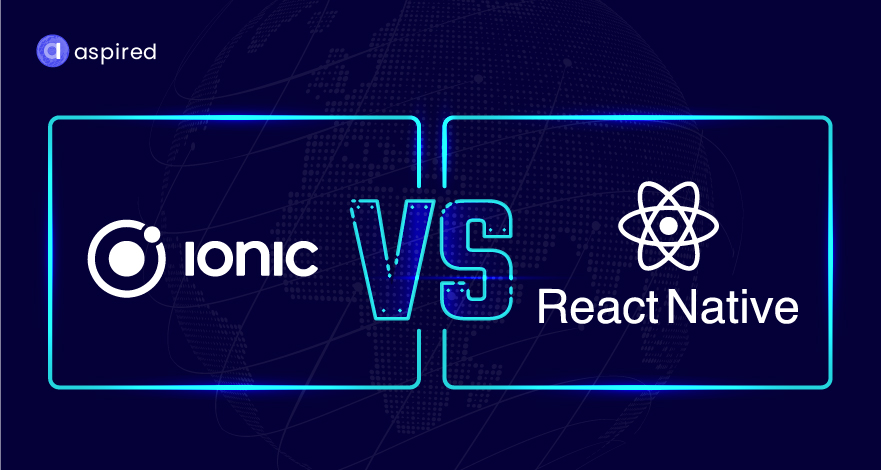Cross-platform mobile development frameworks have taken over the tech world. Gone are the days when Swift was the go-to framework for native iOS development and Java for native android development. The present, and largely the future, belongs to cross-platform, hybrid, and progressive web apps (PWAs).
According to a study by Gartner,70% of all interactions on business software solutions will occur on mobile devices by 2022. Reasonably, many aspiring entrepreneurs look to develop mobile apps for their startups but end up getting stuck in the dilemma of choosing the right platforms for their mobile apps. However, they are not to be blamed for this.
Why Ionic Vs. React Native?
Since there is no such thing as having too many mobile app frameworks in the development industry. Choosing a framework that helps mobile development quickly and cost-effectively is a big question. The answer is to use among the most prevalent cross-platform frameworks; Ionic or React Native.
Ionic and React Native are today's most used and recommended mobile frameworks. Each with its own unique strengths and weaknesses that may make one better than the other depending on a project's requirements. So, which one is better for your business project? Again, that's a difficult ask.
The choice largely depends upon the Project's needs and individual preferences. But, to put an end to this discussion and to crown a winner among the most popular frameworks, this write-up will discuss all the major aspects, including the pros and cons of each framework, to help you make a more informed decision. Read on to learn what makes Ionic better than React Native and vice versa.
What Is Ionic?
Ionic is a popular framework for developing hybrid mobile apps. It is a front-end mobile framework, which means that you will use Ionic to create the user interface and then hook it up with a back-end language such as JavaScript or TypeScript. This means that the app is developed using HTML, CSS, and JavaScript and then packaged into a native app using a tool like Cordova or PhoneGap.
Ionic was created by Drifty Co. in 2013 and since has established a large following of developers in creating cross-platform and hybrid mobile apps. It offers a wide range of features, including support for gestures, animations, and scrolling. It also has a large community of developers who always create new plugins and modules.
What Is React Native?
React Native is a relatively newer framework that Facebook created in 2015. It is based on React, a popular JavaScript library for building user interfaces. React Native has also gained a lot of popularity in a short time, and many libraries and tools are available for it. Many big companies, such as Netflix, Instagram, Airbnb, and Walmart, are now using React Native to develop mobile applications.
The best thing about React Native is that it uses JavaScript for building mobile apps. This allows developers to use one language for both the front-end and back-end of an app, which can make development quicker and easier. In addition, React Native applications are compiled into native code, which means they can run on any device that supports React Native.
Ionic Vs. React Native; Popularity Comparison
There is no doubt in admitting that both Native React and Ionic have grown to become among the most popular mobile app development frameworks. Both frameworks are now being adopted by big company names around the world, developing thousands of mobile apps annually and further stretching the wide community around them.
Ionic According to the data produced by npmtrends , Ionic observed its biggest hike after 2017, when its downloads touched 500K annually. The reason is that it was way more mature then than Native React and offered a more stable development process with clearly fewer bugs. However, the graph started declining after 2019 when Facebook decided to put some muscle in to React Native.
React Native : React Native has beaten Ionic in the race for popularity because of its ability to leverage native components and build comparatively more "native" apps using React and JavaScript. According to the numbers put forward by AppBrain , Ionic contributed to building 26K apps last year, whereas React Native was behind 32K apps. The difference is self-explanatory.
Fact: According to the GitHub community stats, React Native has 23K forks and 102K stars in comparison to Ionic, which has only 13.5K forks and 47K stars.
Verdict:React Native is more popular than Ionic today.
Ionic Vs. React Native; Performance Comparison
The ideal scenario for getting the best performance is to code separately on Android and iOS because it is the only way one can get unabstracted access to the native features and make the most out of them. However, neither React Native nor Ionic can match this standard of native performance since both of them are creating cross-platform apps.
Here is a look at what each of these frameworks offers in terms of performance.
Ionic: Ionic uses the Cordova Plugin to access the native features and doesn't leverage the native components directly, which causes sluggishness. Since Ionic is more suitable for developing web views, it is set to offer better UI and a quicker development process. However, its performance will face a lot of callbacks.
React Native: React Native is more likely to produce a better native-like performance as compared to Ionic. The reason behind this is that React Native uses native building blocks and has a similar look and feel to Native, except for the fact that it uses JavaScript to wrap around these building blocks.
Fact: A Native React App will require very little to no optimization to reach 60 FPS (Frames Per Second). In contrast, an Ionic app with the same amount of data will require a more hands-on optimization approach to come close to 60 FPS.
Verdict: React Native proves better performance in developing complex apps with a greater amount of data.
Which one is Better for my Project?
While Ionic and React Native are both open-source mobile application frameworks, they are very different in how they operate and their main purposes. For example, Ionic was created to allow developers to build web applications using web languages (HTML, CSS, and JavaScript), while React Native focuses on creating native apps for Android and iOS platforms that can be written in JavaScript.
After making detailed comparisons regarding popularity and performance, it is time to list the suitable scenarios for selecting among Ionic or React Native.
Select React Native, if:
- Your developers have hands-on expertise in React
- Your existing website/app is built with React
- You are critical about Native Platform Dependency
- You are not limited with budget and timeline
- Your Project is dependent on Performance Optimization
Select Ionic, if:
- You're looking forward to building a web or desktop app.
- Your developers are more compatible with web technologies.
- Your Project is not dependent upon Performance Optimization
- You are a startup and want to build an app on a "unique" idea
- You have a limited budget or timeframe
Wrapping Up
Ionic and React Native are two of the most popular mobile frameworks on the market. Both have their Pros and Cons, but ultimately it boils down to what you need from a mobile framework.
If you need a framework that is packed with features and easy to use not to mention – geared toward web-based tech stack and developer base, then Ionic is the better choice. However, if you need a more lightweight and faster framework that is more mobile-friendly, React Native is the better option.
It depends on your specific needs regarding which mobile framework is better. However, both Ionic and React Native are great choices for any mobile development project.
Still need help selecting the best mobile app development framework for your Project? Consult with experts at aspired.io and get the best experience and value possible!

 Clients
Clients
 Processes
Processes
 Blog
Blog










